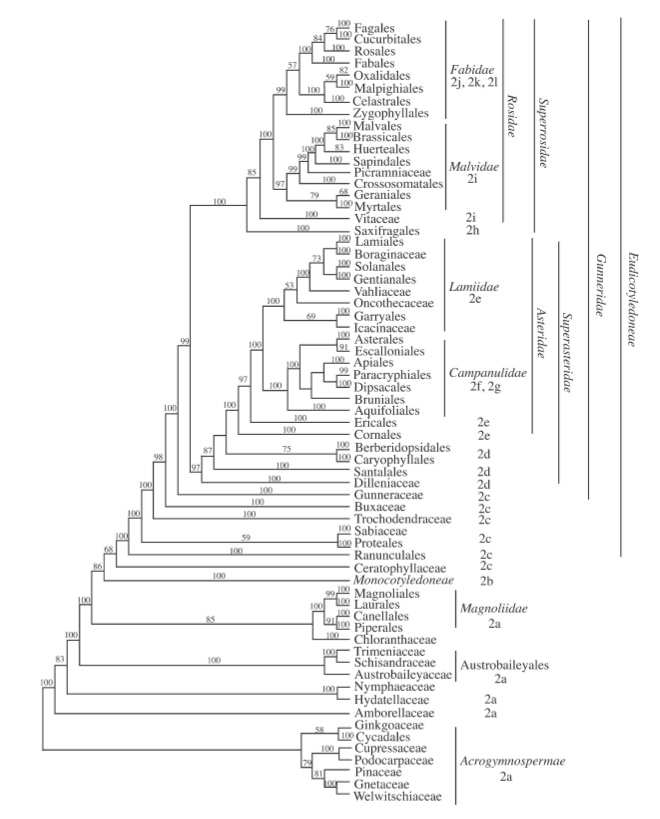Angiosperm phylogeny: 17 genes, 640 taxa.
Our analyses confirm that with large amounts of sequence data, most deep-level relationships within the angiosperms can be resolved. We anticipate that this well-resolved angiosperm tree will be of broad utility for many areas of biology, including physiology, ecology, paleobiology, and genomics.
Angiosperm phylogeny: 17 genes, 640 taxa. 2011. Douglas E. Soltis,, Stephen A. Smith, Nico Cellinese, Kenneth J. Wurdack, David C. Tank, Samuel F. Brockington, Nancy F. Refulio-Rodriguez, Jay B. Walker, Michael J. Moore, Barbara S. Carlsward, Charles D. Bell, Maribeth Latvis,, Sunny Crawley, Chelsea Black, Diaga Diouf,, Zhenxiang Xi, Catherine A. Rushworth, Matthew A. Gitzendanner,, Kenneth J. Sytsma, Yin-Long Qiu, Khidir W. Hilu, Charles C. Davis, Michael J. Sanderson, Reed S. Beaman, Richard G. Olmstead, Walter S. Judd, Michael J. Donoghue and Pamela S. Soltis. American Journal of Botany, 98(4): 704-730.
View at American Journal of Botany.
Abstract:
• Premise of the study: Recent analyses employing up to five genes have provided numerous insights into angiosperm phylogeny, but many relationships have remained unresolved or poorly supported. In the hope of improving our understanding of angiosperm phylogeny, we expanded sampling of taxa and genes beyond previous analyses.
• Methods: We conducted two primary analyses based on 640 species representing 330 families. The first included 25260 aligned base pairs (bp) from 17 genes (representing all three plant genomes, i.e., nucleus, plastid, and mitochondrion). The second included 19846 aligned bp from 13 genes (representing only the nucleus and plastid).
• Key results: Many important questions of deep-level relationships in the nonmonocot angiosperms have now been resolved with strong support. Amborellaceae, Nymphaeales, and Austrobaileyales are successive sisters to the remaining angiosperms (Mesangiospermae), which are resolved into Chloranthales + Magnoliidae as sister to Monocotyledoneae + [Ceratophyllaceae + Eudicotyledoneae]. Eudicotyledoneae contains a basal grade subtending Gunneridae. Within Gunneridae, Gunnerales are sister to the remainder (Pentapetalae), which comprises (1) Superrosidae, consisting ofRosidae (including Vitaceae) and Saxifragales; and (2) Superasteridae, comprising Berberidopsidales, Santalales, Caryophyllales, Asteridae, and, based on this study, Dilleniaceae (although other recent analyses disagree with this placement). Within the major subclades of Pentapetalae, most deep-level relationships are resolved with strong support.
• Conclusions: Our analyses confirm that with large amounts of sequence data, most deep-level relationships within the angiosperms can be resolved. We anticipate that this well-resolved angiosperm tree will be of broad utility for many areas of biology, including physiology, ecology, paleobiology, and genomics.
